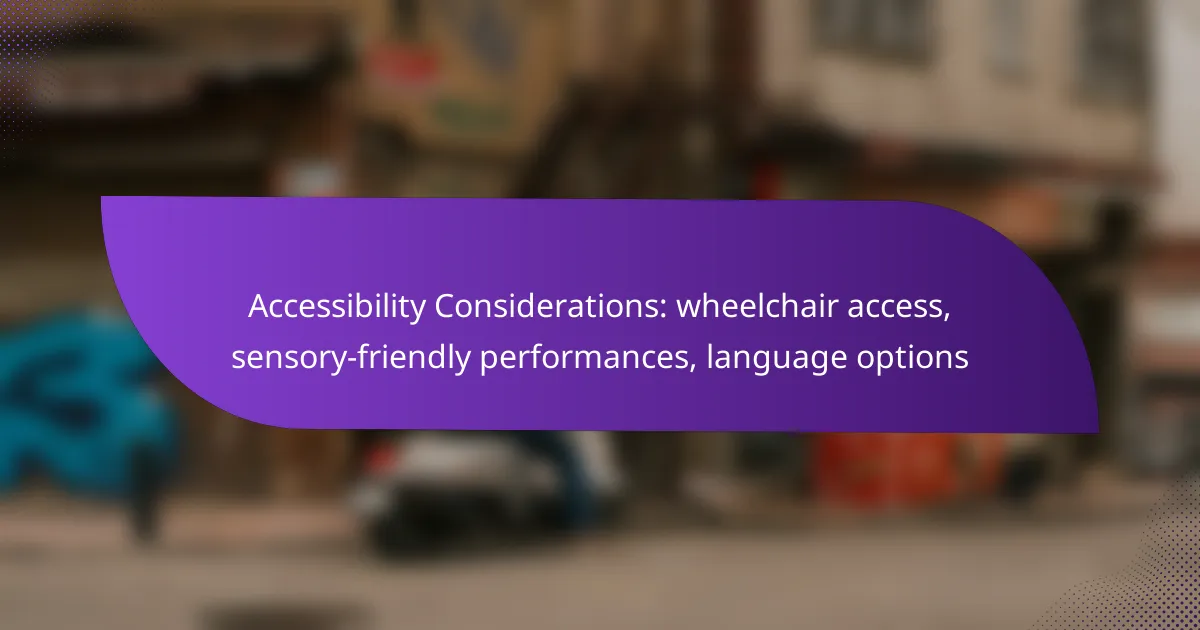Accessibility considerations are essential for creating inclusive environments that cater to diverse needs. This includes ensuring wheelchair access across venues, offering sensory-friendly performances to accommodate individuals with sensory sensitivities, and providing various language options such as British Sign Language interpretation and audio descriptions. By prioritizing these elements, we can enhance the experience for all attendees and promote equal access to events and facilities.

What are the wheelchair access options in the UK?
In the UK, wheelchair access options vary widely across venues, public transport, and facilities. Many establishments are increasingly prioritizing accessibility, ensuring that individuals with mobility challenges can navigate spaces comfortably and safely.
Accessible venues in London
London boasts numerous accessible venues, including theaters, museums, and restaurants. Many of these locations offer features such as designated wheelchair seating, accessible restrooms, and staff trained to assist guests with disabilities. Checking a venue’s website or contacting them directly can provide specific information about their accessibility options.
Public transport accessibility
Public transport in London is designed to be accessible, with many buses and trains equipped with ramps and designated spaces for wheelchair users. The Transport for London (TfL) website provides detailed information on accessible routes and services, helping users plan their journeys effectively. However, not all stations are fully accessible, so it’s advisable to check in advance.
Wheelchair ramps and lifts
Wheelchair ramps and lifts are essential for ensuring access to buildings and public transport. In the UK, regulations require new buildings to include these features, but older structures may lack adequate facilities. When visiting a venue, look for signs indicating the location of ramps and lifts, and don’t hesitate to ask staff for assistance if needed.
Accessibility standards compliance
Compliance with accessibility standards, such as the Equality Act 2010, is crucial for public venues in the UK. This legislation mandates that service providers make reasonable adjustments to accommodate individuals with disabilities. Regular audits and feedback from users can help ensure that venues maintain high standards of accessibility and improve where necessary.

How can sensory-friendly performances be implemented?
Sensory-friendly performances can be implemented by creating an environment that accommodates individuals with sensory sensitivities. This involves adjusting various elements of the performance space to reduce overwhelming stimuli and enhance comfort for all attendees.
Quiet hours in theatres
Quiet hours in theatres refer to designated times when noise levels are minimized, allowing for a more peaceful experience. During these hours, loud sound effects and music are toned down or eliminated, making it easier for individuals with auditory sensitivities to enjoy the performance.
Theatres can schedule specific performances as quiet hours, ensuring that patrons are aware of these options in advance. This approach not only helps those with sensory sensitivities but can also create a more relaxed atmosphere for all audience members.
Adjustable lighting and sound
Adjustable lighting and sound are crucial components of sensory-friendly performances. The ability to modify lighting levels and sound intensity allows theatres to cater to various sensory needs, providing a more comfortable environment for attendees.
Theatres should invest in technology that enables staff to easily control these elements during performances. For instance, using dimmable lights and sound systems with volume controls can help create an optimal experience for individuals who may be sensitive to bright lights or loud noises.
Special seating arrangements
Special seating arrangements can enhance the experience for individuals requiring sensory-friendly accommodations. This might include designated areas with more space between seats or options for patrons to sit in quieter sections of the theatre.
Additionally, providing seating that allows for easy access to exits can help individuals feel more secure. Theatres should clearly communicate these options when selling tickets, ensuring that patrons know where to find the most comfortable seating for their needs.

What language options are available for performances?
Performances often provide various language options to enhance accessibility for diverse audiences. These options typically include British Sign Language interpretation, audio description services, and subtitles or captioning, catering to different communication needs.
British Sign Language interpretation
British Sign Language (BSL) interpretation allows deaf and hard-of-hearing audiences to fully engage with performances. BSL interpreters translate spoken dialogue and important sounds into sign language, ensuring that the essence of the performance is conveyed. It’s essential to check in advance if a performance offers BSL interpretation, as not all shows provide this service.
When attending a performance with BSL interpretation, look for designated seating areas that provide a clear view of the interpreter. This enhances the experience by allowing for better visual engagement with both the interpreter and the performance itself.
Audio description services
Audio description services provide a spoken narration of visual elements during a performance, assisting blind or visually impaired audience members. This service typically describes actions, settings, and costumes, enriching the overall experience. Many theaters offer audio description through headsets or mobile apps, so it’s advisable to inquire about availability when booking tickets.
To maximize the benefit of audio description, consider attending a performance that includes a pre-show audio introduction. This can provide context and enhance understanding of the narrative before the show begins.
Subtitles and captioning
Subtitles and captioning display text on screen to convey spoken dialogue and important sound cues, making performances accessible to those who are deaf or hard of hearing. Subtitles typically translate the spoken word, while captioning may include additional information about sound effects and music. Many theaters now offer these options, especially for films and televised performances.
When selecting a performance, check if the venue provides options for subtitles or captioning, as this can vary widely. Some venues may also offer the ability to adjust the size and color of the text for better visibility, which can be particularly helpful for those with visual impairments.

What are the legal requirements for accessibility in the UK?
The legal requirements for accessibility in the UK are primarily governed by the Equality Act 2010 and specific building regulations. These laws ensure that public spaces are accessible to individuals with disabilities, including wheelchair users and those requiring sensory-friendly environments.
Equality Act 2010 compliance
The Equality Act 2010 mandates that service providers make reasonable adjustments to ensure that disabled individuals can access their services. This includes physical adaptations, such as installing ramps and accessible restrooms, as well as providing assistance or alternative formats for communication.
Organizations must assess their facilities and services to identify barriers that may prevent access. Regular training for staff on disability awareness and customer service can help improve the overall experience for disabled patrons.
Building regulations for accessibility
Building regulations in the UK outline specific standards for accessibility in new constructions and major renovations. These regulations require that public buildings, such as theatres and shopping centers, include features like wide doorways, elevators, and designated parking spaces for disabled individuals.
Compliance with these regulations is essential not only for legal reasons but also to foster an inclusive environment. Regular audits and updates to facilities can help ensure ongoing compliance and improve accessibility for all users.

How can venues improve their accessibility features?
Venues can enhance their accessibility features by implementing comprehensive strategies that address physical access, sensory accommodations, and communication options. This includes regular assessments of facilities, staff training, and incorporating feedback from individuals with disabilities.
Regular accessibility audits
Conducting regular accessibility audits is crucial for identifying barriers that may hinder access for individuals with disabilities. These audits should evaluate physical spaces, such as entrances, restrooms, and seating areas, ensuring compliance with local regulations and standards.
Audits can be performed by trained professionals or through self-assessments using checklists that cover various aspects of accessibility. Venues should aim to conduct these audits annually or biannually to stay updated on any necessary improvements.
Staff training on accessibility
Training staff on accessibility is essential for creating an inclusive environment. Employees should be educated on the specific needs of individuals with disabilities, including how to assist them effectively and respectfully.
Training programs can include workshops, online courses, and role-playing scenarios to prepare staff for real-life situations. Regular refresher courses can help maintain awareness and ensure that all staff members are equipped to support guests with diverse accessibility needs.

What are the emerging trends in accessibility for performances?
Emerging trends in accessibility for performances focus on enhancing inclusivity through wheelchair access, sensory-friendly options, and diverse language offerings. These developments aim to create environments where all audience members can enjoy the experience fully and comfortably.
Wheelchair Access
Wheelchair access is becoming a standard requirement for venues hosting performances. This includes features like ramps, designated seating areas, and accessible restrooms. Venues are increasingly adopting universal design principles to ensure that all patrons can navigate spaces easily.
When planning an event, consider the layout of the venue. Ensure that pathways are clear and that seating arrangements accommodate wheelchair users. It’s also beneficial to provide staff training on assisting individuals with mobility challenges.
Sensory-Friendly Performances
Sensory-friendly performances are designed to create a comfortable environment for individuals with sensory sensitivities. These events often feature adjusted lighting, reduced sound levels, and quiet areas for those needing a break. Such adaptations help to minimize overstimulation and anxiety.
To implement sensory-friendly options, consider scheduling specific performances that cater to this audience. Communicate clearly about the modifications made to the show, so attendees know what to expect. Providing sensory kits with items like noise-canceling headphones can also enhance the experience.
Language Options
Offering multiple language options for performances is increasingly important for accessibility. This can include translated programs, subtitles, or live interpretation services. Providing these options helps to engage a broader audience and ensures that non-native speakers can fully participate.
When planning for language accessibility, assess the demographics of your audience. Consider offering materials in the most commonly spoken languages in your community. Additionally, using technology such as mobile apps for real-time translation can enhance the experience for attendees who require language support.
